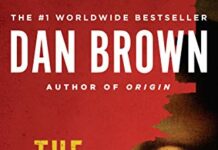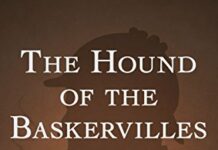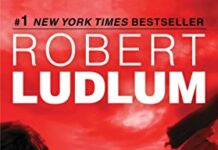
Ebook Info
- Published: 2009
- Number of pages: 626 pages
- Format: Epub
- File Size: 1.22 MB
- Authors: Dan Brown
Description
Famed Harvard symbologist Robert Langdon answers an unexpected summons to appear at the U.S. Capitol Building. His plans are interrupted when a disturbing object—artfully encoded with five symbols—is discovered in the building. Langdon recognizes in the find an ancient invitation into a lost world of esoteric, potentially dangerous wisdom.
When his mentor Peter Solomon—a long-standing Mason and beloved philanthropist—is kidnapped, Langdon realizes that the only way to save Solomon is to accept the mystical invitation and plunge headlong into a clandestine world of Masonic secrets, hidden history, and one inconceivable truth … all under the watchful eye of Dan Brown’s most terrifying villain to date.
User’s Reviews
Amazon.com Review Let’s start with the question every The Lost Symbol as good as The Da Vinci Code? Simply put, yes. Brown has mastered the art of blending nail-biting suspense with random arcana (from pop science to religion), and The Lost Symbol is an enthralling mix. And what a dazzling accomplishment that is, considering that rabid fans and skeptics alike are scrutinizing every word. The Lost Symbol begins with an ancient ritual, a shadowy enclave, and of course, a secret. Readers know they are in Dan Brown territory when, by the end of the first chapter, a secret within a secret is revealed. To tell too much would ruin the fun of reading this delicious thriller, so you will find no spoilers here. Suffice it to say that as with many series featuring a recurring character, there is a bit of a formula at work (one that fans will love). Again, brilliant Harvard professor Robert Langdon finds himself in a predicament that requires his vast knowledge of symbology and superior problem-solving skills to save the day. The setting, unlike other Robert Langdon novels, is stateside, and in Brown’s hands Washington D.C. is as fascinating as Paris or Vatican City (note to the D.C. tourism board: get your “Lost Symbol” tour in order). And, as with other Dan Brown books, the pace is relentless, the revelations many, and there is an endless parade of intriguing factoids that will make you feel like you are spending the afternoon with Robert Langdon and the guys from Mythbusters. Nothing is as it seems in a Robert Langdon novel, and The Lost Symbol itself is no exception–a page-turner to be sure, but Brown also challenges his fans to open their minds to new information. Skeptical? Imagine how many other thrillers would spawn millions of Google searches for noetic science, superstring theory, and Apotheosis of Washington. The Lost Symbol is brain candy of the best sort–just make sure to set aside time to enjoy your meal. –Daphne Durham Review “Dan Brown brings sexy back to a genre that had been left for dead…His code and clue-filled book is dense with exotica…amazing imagery…and the nonstop momentum that makes The Lost Symbol impossible to put down. SPLENDID…ANOTHER MIND-BLOWING ROBERT LANGDON STORY.”—Janet Maslin, New York Times”THRILLING IN THE EXTREME, A DEFINITE PAGE-FLIPPER.”—Daily News (New York)”Call it Brownian motion: A COMET TAIL-RIDE of beautifully spaced reveals and a socko unveiling of the killer’s true identity.”—Washington Post”The wait is over. The Lost Symbol is here–and you don’t have to be a Freemason to enjoy it….THRILLING AND ENTERTAINING, LIKE THE EXPERIENCE ON A ROLLER COASTER.”—Los Angeles Times”ROBERT LANGDON REMAINS A TERRIFIC HERO, a bookish intellectual who’s cool in a crisis and quick on his feet…. The codes are intriguing, the settings present often-seen locales in a fresh light, and Brown keeps the pages turning.”—Entertainment Weekly Excerpt. © Reprinted by permission. All rights reserved. PrologueHouse of the Temple8:33 P.M. The secret is how to die.Since the beginning of time, the secret had always been how to die.The thirty-four-year-old initiate gazed down at the human skull cradled in his palms. The skull was hollow, like a bowl, filled with bloodred wine.Drink it, he told himself. You have nothing to fear. As was tradition, he had begun this journey adorned in the ritualistic garb of a medieval heretic being led to the gallows, his loose-fitting shirt gaping open to reveal his pale chest, his left pant leg rolled up to the knee, and his right sleeve rolled up to the elbow. Around his neck hung a heavy rope noose—a “cable-tow” as the brethren called it. Tonight, however, like the brethren bearing witness, he was dressed as a master.The assembly of brothers encircling him all were adorned in their full regalia of lambskin aprons, sashes, and white gloves. Around their necks hung ceremonial jewels that glistened like ghostly eyes in the muted light. Many of these men held powerful stations in life, and yet the initiate knew their worldly ranks meant nothing within these walls. Here all men were equals, sworn brothers sharing a mystical bond.As he surveyed the daunting assembly, the initiate wondered who on the outside would ever believe that this collection of men would assemble in one place . . . much less this place. The room looked like a holy sanctuary from the ancient world.The truth, however, was stranger still.I am just blocks away from the White House.This colossal edifice, located at 1733 Sixteenth Street NW in Washington, D.C., was a replica of a pre-Christian temple—the temple of King Mausolus, the original mausoleum . . . a place to be taken after death. Outside the main entrance, two seventeen-ton sphinxes guarded the bronze doors. The interior was an ornate labyrinth of ritualistic chambers, halls, sealed vaults, libraries, and even a hollow wall that held the remains of two human bodies. The initiate had been told every room in this building held a secret, and yet he knew no room held deeper secrets than the gigantic chamber in which he was currently kneeling with a skull cradled in his palms.The Temple Room.This room was a perfect square. And cavernous. The ceiling soared an astonishing one hundred feet overhead, supported by monolithic columns of green granite. A tiered gallery of dark Russian walnut seats with hand-tooled pigskin encircled the room. A thirty-three-foot-tall throne dominated the western wall, with a concealed pipe organ opposite it. The walls were a kaleidoscope of ancient symbols . . . Egyptian, Hebraic, astronomical, alchemical, and others yet unknown.Tonight, the Temple Room was lit by a series of precisely arranged candles. Their dim glow was aided only by a pale shaft of moonlight that filtered down through the expansive oculus in the ceiling and illuminated the room’s most startling feature—an enormous altar hewn from a solid block of polished Belgian black marble, situated dead center of the square chamber.The secret is how to die, the initiate reminded himself.”It is time,” a voice whispered.The initiate let his gaze climb the distinguished white-robed figure standing before him. The Supreme Worshipful Master. The man, in his late fifties, was an American icon, well loved, robust, and incalculably wealthy. His once-dark hair was turning silver, and his famous visage reflected a lifetime of power and a vigorous intellect.”Take the oath,” the Worshipful Master said, his voice soft like falling snow. “Complete your journey.”The initiate’s journey, like all such journeys, had begun at the first degree. On that night, in a ritual similar to this one, the Worshipful Master had blindfolded him with a velvet hoodwink and pressed a ceremonial dagger to his bare chest, demanding: “Do you seriously declare on your honor, uninfluenced by mercenary or any other unworthy motive, that you freely and voluntarily offer yourself as a candidate for the mysteries and privileges of this brotherhood?””I do,” the initiate had lied.”Then let this be a sting to your consciousness,” the master had warned him, “as well as instant death should you ever betray the secrets to be imparted to you.”At the time, the initiate had felt no fear. They will never know my true purpose here.Tonight, however, he sensed a foreboding solemnity in the Temple Room, and his mind began replaying all the dire warnings he had been given on his journey, threats of terrible consequences if he ever shared the ancient secrets he was about to learn: Throat cut from ear to ear . . . tongue torn out by its roots . . . bowels taken out and burned . . . scattered to the four winds of heaven . . . heart plucked out and given to the beasts of the field—”Brother,” the gray-eyed master said, placing his left hand on the initiate’s shoulder. “Take the final oath.”Steeling himself for the last step of his journey, the initiate shifted his muscular frame and turned his attention back to the skull cradled in his palms. The crimson wine looked almost black in the dim candlelight. The chamber had fallen deathly silent, and he could feel all of the witnesses watching him, waiting for him to take his final oath and join their elite ranks.Tonight, he thought, something is taking place within these walls that has never before occurred in the history of this brotherhood. Not once, in centuries.He knew it would be the spark . . . and it would give him unfathomable power. Energized, he drew a breath and spoke aloud the same words that countless men had spoken before him in countries all over the world.”May this wine I now drink become a deadly poison to me . . . should I ever knowingly or willfully violate my oath.”His words echoed in the hollow space.Then all was quiet.Steadying his hands, the initiate raised the skull to his mouth and felt his lips touch the dry bone. He closed his eyes and tipped the skull toward his mouth, drinking the wine in long, deep swallows. When the last drop was gone, he lowered the skull.For an instant, he thought he felt his lungs growing tight, and his heart began to pound wildly. My God, they know! Then, as quickly as it came, the feeling passed.A pleasant warmth began to stream through his body. The initiate exhaled, smiling inwardly as he gazed up at the unsuspecting gray-eyed man who had foolishly admitted him into this brotherhood’s most secretive ranks.Soon you will lose everything you hold most dear.Chapter 1The Otis elevator climbing the south pillar of the Eiffel Tower was overflowing with tourists. Inside the cramped lift, an austere businessman in a pressed suit gazed down at the boy beside him. “You look pale, son. You should have stayed on the ground.””I’m okay . . .” the boy answered, struggling to control his anxiety. “I’ll get out on the next level.” I can’t breathe.The man leaned closer. “I thought by now you would have gotten over this.” He brushed the child’s cheek affectionately.The boy felt ashamed to disappoint his father, but he could barely hear through the ringing in his ears. I can’t breathe. I’ve got to get out of this box!The elevator operator was saying something reassuring about the lift’s articulated pistons and puddled-iron construction. Far beneath them, the streets of Paris stretched out in all directions.Almost there, the boy told himself, craning his neck and looking up at the unloading platform. Just hold on.As the lift angled steeply toward the upper viewing deck, the shaft began to narrow, its massive struts contracting into a tight, vertical tunnel.”Dad, I don’t think—”Suddenly a staccato crack echoed overhead. The carriage jerked, swaying awkwardly to one side. Frayed cables began whipping around the carriage, thrashing like snakes. The boy reached out for his father.”Dad!”Their eyes locked for one terrifying second.Then the bottom dropped out.Robert Langdon jolted upright in his soft leather seat, startling out of the semiconscious daydream. He was sitting all alone in the enormous cabin of a Falcon 2000EX corporate jet as it bounced its way through turbulence. In the background, the dual Pratt & Whitney engines hummed evenly.”Mr. Langdon?” The intercom crackled overhead. “We’re on final approach.”Langdon sat up straight and slid his lecture notes back into his leather daybag. He’d been halfway through reviewing Masonic symbology when his mind had drifted. The daydream about his late father, Langdon suspected, had been stirred by this morning’s unexpected invitation from Langdon’s longtime mentor, Peter Solomon.The other man I never want to disappoint.The fifty-eight-year-old philanthropist, historian, and scientist had taken Langdon under his wing nearly thirty years ago, in many ways filling the void left by Langdon’s father’s death. Despite the man’s influential family dynasty and massive wealth, Langdon had found humility and warmth in Solomon’s soft gray eyes.Outside the window the sun had set, but Langdon could still make out the slender silhouette of the world’s largest obelisk, rising on the horizon like the spire of an ancient gnomon. The 555-foot marble-faced obelisk marked this nation’s heart. All around the spire, the meticulous geometry of streets and monuments radiated outward.Even from the air, Washington, D.C., exuded an almost mystical power.Langdon loved this city, and as the jet touched down, he felt a rising excitement about what lay ahead. The jet taxied to a private terminal somewhere in the vast expanse of Dulles International Airport and came to a stop.Langdon gathered his things, thanked the pilots, and stepped out of the jet’s luxurious interior onto the foldout staircase. The cold January air felt liberating.Breathe, Robert, he thought, appreciating the wide-open spaces.A blanket of white fog crept across the runway, and Langdon had the sensation he was stepping into a marsh as he descended onto the misty tarmac.”Hello! Hello!” a singsong British voice shouted from across the tarmac. “Professor Langdon?”Langdon looked up to see a middle-aged woman with a badge and clipboard hurrying toward him, waving happily as he approached. Curly blond hair protruded from under a stylish knit wool hat.”Welcome to Washington, sir!”Langdon smiled. “Thank you.””My name is Pam, from passenger services.” The woman spoke with an exuberance that was almost unsettling. “If you’ll come with me, sir, your car is waiting.”Langdon followed her across the runway toward the Signature terminal, which was surrounded by glistening private jets. A taxi stand for the rich and famous.”I hate to embarrass you, Professor,” the woman said, sounding sheepish, “but you are the Robert Langdon who writes books about symbols and religion, aren’t you?”Langdon hesitated and then nodded.”I thought so!” she said, beaming. “My book group read your book about the sacred feminine and the church! What a delicious scandal that one caused! You do enjoy putting the fox in the henhouse!”Langdon smiled. “Scandal wasn’t really my intention.”The woman seemed to sense Langdon was not in the mood to discuss his work. “I’m sorry. Listen to me rattling on. I know you probably get tired of being recognized . . . but it’s your own fault.” She playfully motioned to his clothing. “Your uniform gave you away.”My uniform? Langdon glanced down at his attire. He was wearing his usual charcoal turtleneck, Harris Tweed jacket, khakis, and collegiate cordovan loafers . . . his standard attire for the classroom, lecture circuit, author photos, and social events.The woman laughed. “Those turtlenecks you wear are so dated. You’d look much sharper in a tie!”No chance, Langdon thought. Little nooses.Neckties had been required six days a week when Langdon attended Phillips Exeter Academy, and despite the headmaster’s romantic claims that the origin of the cravat went back to the silk fascalia worn by Roman orators to warm their vocal cords, Langdon knew that, etymologically, cravat actually derived from a ruthless band of “Croat” mercenaries who donned knotted neckerchiefs before they stormed into battle. To this day, this ancient battle garb was donned by modern office warriors hoping to intimidate their enemies in daily boardroom battles.”Thanks for the advice,” Langdon said with a chuckle. “I’ll consider a tie in the future.”Mercifully, a professional-looking man in a dark suit got out of a sleek Lincoln Town Car parked near the terminal and held up his finger. “Mr. Langdon? I’m Charles with Beltway Limousine.” He opened the passenger door. “Good evening, sir. Welcome to Washington.”Langdon tipped Pam for her hospitality and then climbed into the plush interior of the Town Car. The driver showed him the temperature controls, the bottled water, and the basket of hot muffins. Seconds later, Langdon was speeding away on a private access road. So this is how the other half lives.As the driver gunned the car up Windsock Drive, he consulted his passenger manifest and placed a quick call. “This is Beltway Limousine,” the driver said with professional efficiency. “I was asked to confirm once my passenger had landed.” He paused. “Yes, sir. Your guest, Mr. Langdon, has arrived, and I will deliver him to the Capitol Building by seven P.M. You’re welcome, sir.” He hung up.Langdon had to smile. No stone left unturned. Peter Solomon’s attention to detail was one of his most potent assets, allowing him to manage his substantial power with apparent ease. A few billion dollars in the bank doesn’t hurt either.Langdon settled into the plush leather seat and closed his eyes as the noise of the airport faded behind him. The U.S. Capitol was a half hour away, and he appreciated the time alone to gather his thoughts. Everything had happened so quickly today that Langdon only now had begun to think in earnest about the incredible evening that lay ahead.Arriving under a veil of secrecy, Langdon thought, amused by the prospect.Ten miles from the Capitol Building, a lone figure was eagerly preparing for Robert Langdon’s arrival. –This text refers to an alternate kindle_edition edition. From AudioFile THE LOST SYMBOL is yet another foray by Dan Brown into the human connection with mysticism, this time within the world of Freemasonry. Performer Paul Michael faced a challenge in portraying Brown’s hero, Harvard professor Robert Langdon, because of the compelling acting of Tom Hanks in the film versions of THE DA VINCI CODE and ANGELS AND DEMONS. Surely THE LOST SYMBOL is headed for the big screen as well as Langdon tries to save a friend from a madman by discovering the truth behind one of Masonry’s biggest secrets. Narrator Michael makes the character his own as he maintains a level of suspense throughout the book, which sometimes falls victim to laborious exposition. He manages to inject tension into each scene, keeping the listener eager for more. M.S. © AudioFile 2009, Portland, Maine –This text refers to an alternate kindle_edition edition.
Reviews from Amazon users, collected at the time the book is getting published on UniedVRG. It can be related to shiping or paper quality instead of the book content:
⭐ It’s kind of hard to write a review about a book of fiction without giving away too much of the story itself, but let me give it a try. I read the Kindle version of this book, so I know that some other reviewers have pointed out how the print version was over 600 pages long. I read the book over several sittings, but I didn’t feel the weight of 600 pages as the book is fairly well paced with very short chapters. What I liked about the book was that it kept me entertained for the most part. What I disliked about the book was the climax, which included the origin of Mal’akh (the antagonist). That and pretty much the rest of the book from there just didn’t work for me. After having the origin Mal’akh explained, I found the motives of the character too weak for the extreme nature of his behavior. Additionally, the entire involvement of the CIA and the treatment of the events of the story as being a matter of national security to them: also too much for me to believe once it is all explained out. The biggest let down of the book is what happens after the climax. All of the main characters of the book, such as Robert Langdon, Peter Solomon, and Katherine Solomon, seem to just bounce back to their happy philosophical selves after just a couple of hours from the time of the climax of the book. If we’re supposed to believe how the world was about to end and considering the loss of life and/or near death experiences, the revelation of who Mal’akh is, and the blowing of some of the greatest secrets of the Freemasons, it just seemed absurd that the main characters of the book so quickly return to life-before-end-of-world-climax selves.
⭐ Does Brown have an editor anymore or has his success allowed him to write anything? I suspect the latter. This book is tedious, overwrought and full of crap to be blunt. Noetic Science is junk science. Masonic conspiracies are overblown. National crisis, I think not. On by the way, the CIA by law is prohibited from operating domestically. The head of the CIA Office of Security has NO jurisdiction! Not to mention she was basically modeled on Edna from the Incredibles. The antagonists real identity is obvious half way through. The whole book could lose 100 pages easily. It repeats the same quasi-philosophical crap 3x times. Lastly, the updated 21 grams experiment made me laugh out loud. Thoughts dont have mass, random number generators didnt sync up, world consciousness isnt a thing etc.
⭐ 626 pages5 starsProfessor Robert Langdon gets a call from the personal assistant of his old friend Peter Solomon asking him to come to Washington, DC immediately. When he gets to the meeting place, there is no one there. Instead, Robert witnesses an horrific find. Langdon recognizes the gruesome artifact. Almost immediately the director from a secretive branch of the CIA called OS shows up. Ms. Sato is a firebrand. Also among those present is Officer Anderson, the chief of the building security.Langdon gets a call from someone he now recognizes is a very real threat to Peter. This man has planted the find and escaped the building unnoticed. Langdon was tricked into coming to DC. The caller tells him the he must find something and Peter is the one who told him to call Robert. He says Peter said Robert is the only one who can find what the caller wants.With the madman egging him on, Langdon, Sato and others are racing around DC looking for the mysterious artifact the killer wants.The reader gets to be a first-person witness to the search. We learn much about the architecture of Washington, the hidden meanings and about why the founding fathers designed things the way they did.This book is fast moving and very exciting. Robert Langdon is a remarkable character. Intelligent and quick thinking, he keeps the action moving along at a fast pace. Katherine Solomon, Peter’s younger sister, plays a key role in the book as well. She, too, is extremely bright and is studying the science of noetics.I found the whole discussion of noetics very interesting.I surely hope Dan Brown is now working on another Robert Langdon adventure!! Please?
⭐ Dan Brown makes you realize that the mind of man has not begun to reach its fullest potential. He takes historical places, people, and written words and has us looking at them in a different light. He has the ability to to form a storyline that makes us think. Though this is a fictional story much of what he writes about could possibly become a reality in the future. This is another book that will make a great movie. You won’t be able to put the book down once you start to read it!
⭐ If you like a fast moving story that will keep you on the edge of your chair I recommend The Lost Symbol. I is a continuation of the exploits of Robert Langdon, a Harvard symbologist set in our nations capitol. His long time friend Peter Solomon, a 33 degree Mason has presumably called him to Washington for a speech, When Langdon arrives he finds the hand of his friend in the capitol rotunda. The Capitol police and the Chief of Security for the CIA, are trying to unravel the mystery of Peters disappearance and how this all ties together, It is a great read for action genre fans.
⭐ Brown doesn’t raise the bet this time around. He’s been holding a good hand and is playing it safe. Rather than flash his ace, Robert Langdon, he lets the other cards in the deck move the game along. For much of the action, Langdon resembles a joker rather than the ace. Still entertaining to follow the flow of the other players. Brown keeps some of his cards close to his vest and provides a twist or two towards the end of the game. The pot is still a battle between science and religion and some good research is the ante that keeps the game interesting. Readers should not fold their cards before the last hand is played.
⭐ I had read Brown’s two earlier books, and enjoyed them. But this one was extremely long winded and the premise was so complicated as too be thoroughly outlandish! I’m all to aware of how many of our forefathers were masons, and I’m sure many of their symbols are all over WAshington DC. But for one thing, there were so many different characters in this book, that it was hard to keep track of all of them. One minute the character was very evil, next minute they were actually doing good. I especially thought the character of the CIA woman was kind of unbelieveable and almost stereotyped. And of course, there were Jews involved in all this all of whom are wealthy and very intelligent, and maybe ju because of the current political and social climate is making me very uncomfortable reading books that insists on putting people into these stereotypes, I found this book a bit unpalatable.Definitely wasn’t my cup of tea at all.
⭐ What happened to Dan Brown? Could you just not think of a better plot? What I couldn’t get past was all these educated people just allowing this woman from the CIA to trample over everyone’s rights. Why didn’t anyone say, “Excuse me, you have no jurisdiction in this matter, you are not a law enforcement agency, and this is American soil, we are Americans, and there is nothing International about this.” I kept waiting for someone to call her out. Also, the pyramids were person property. Where were their warrants? Finally, when it was revealed what the earth shattering threat to national security was, I actually thought, “Seriously?” I am not going to spoil it, but seriously? Would anyone care?All of his characters tend to histrionics, but in this one they are histrionics and just a little dim. And as old as the pyramids are supposed to be, could they really have hidden the clues on them the way they did, several hundred ago, with out the clues deteriorating over time.Luckily this is Dan Browns worst. I mean his writing doesn’t get any worse than this , well, not yet anyway.
⭐ Dan Brown continues to dig deeper into the spiritual meanings of Life. And Robert Langdon, his intellectual professor, is evolving as the story unfolds.The Lost Symbol, set in our Nation’s Capital, is a wondrous journey through the myths and mists of time as well as the brilliant light of scientific discovery in the present day.Looking through the eyes of the Solomon family, long time members of the Scottish Rite Masonic Temple, we are slowly exposed to ever expanding levels of hidden information.Racing to prevent a breach in national security, Inoue Sato of the CIA works at seemingly cross-purposes against Peter and Katherine Solomon who are on the edge of cutting edge science discoveries affecting the growth of consciousness.From Monuments to private homes, to the Capital to secret hideaways, events escalate to a breathless pace and a stunning conclusion. One of Dan Brown’s best, and overlooked novels.
⭐ Honestly, I find ‘Lost Symbol’ somewhat disappointing, to put it mildly. It lacks Brown’s signature pace and suspense. While Langdon’s disbelief works as valid plot point in the beginning, its stubborn persistence throughout the novel reduces our favorite imaginary Harvard professor to really thick buffoon. Main villain’s motives do not seem plausible enough to validate his actions and even twist in the end does not improve overall impression. Author waits way too long to introduce reader with actual stakes. As a result, reader is faced with hundreds of pages of vague and empty hints at – nothing. I found myself bored out of my mind through long stretches of useless content, wondering should I persevere or simply give up. At times it seems as if novel will recuperate and kick off in real Brown style only to fall flat again and bore reader for another block of pages. I think cutting out between 150 and 200 pages would dramatically improve quality without losing meaningful content. I know we all have bad day here and there but with 600 plus pages I’d say Brown had bad year(s). Hopefully, next novel in Langdon series is significantly better. That is, if I decide there will be next time…
Keywords
Free Download The Lost Symbol: Featuring Robert Langdon in Epub format
The Lost Symbol: Featuring Robert Langdon Epub Free Download
Download The Lost Symbol: Featuring Robert Langdon 2009 Epub Free
The Lost Symbol: Featuring Robert Langdon 2009 Epub Free Download
Download The Lost Symbol: Featuring Robert Langdon Epub
Free Download Ebook The Lost Symbol: Featuring Robert Langdon





